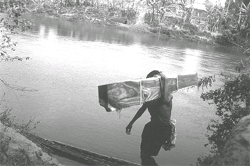Trouble in Tripura
 Brata Kumar Reang, a farmer from Gachhimpara village of Dashda block in the extremist-dominated Dhalai district of north Tripura has had to barter his son in exchange for just 10 kg of rice. Unable to feed his family, Reang first sold his cattle and when the situation got worse, he sold his four-year-old son to his neighbour, who was a little better off than him.
Brata Kumar Reang, a farmer from Gachhimpara village of Dashda block in the extremist-dominated Dhalai district of north Tripura has had to barter his son in exchange for just 10 kg of rice. Unable to feed his family, Reang first sold his cattle and when the situation got worse, he sold his four-year-old son to his neighbour, who was a little better off than him.
The hill tracts of Tripura suffer from a severe food crisis during the dry spell between November and March almost every year. Starvation deaths are very common in this area. "But though incidents like the Gachhimpara case are rare, they are not unheard of,' says Partho Deb of Dainik Sambad, Tripura's leading newspaper.
Incidentally, the state has not received its share of pre-monsoon showers which start as early as February. "In fact, the total rainfall in the state has been going down for the past ten years,' says Deb. "This has resulted in low intensity drought that hits the state year after year,' says Anu Mukherji, president, Tripura Adibashi Mahila Samity, an Agartala-based non-governmental organisation (ngo). "But lack of rains is not the only reason for the food crisis in Tripura. It is the restriction on jhum cultivation,' she adds.
Jhum cultivation Tribals in Tripura traditionally depended on shifting cultivation
